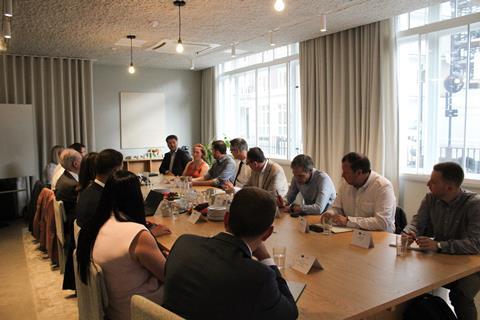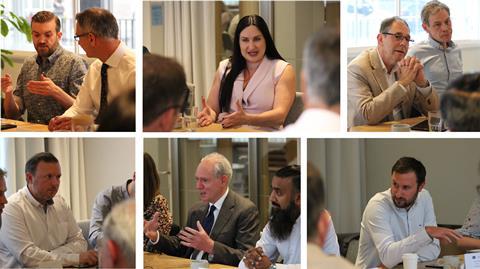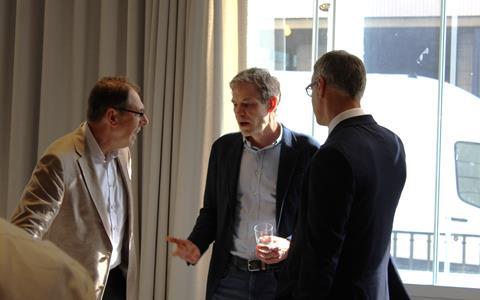Senior industry professionals gathered to share their diverse perspectives on the rapidly changing world of data centres and the dynamic growth of this construction sub-sector, at a roundtable hosted by Jubb and Building magazine

“The recent rise in technologies such as AI and IoT – internet of things – is only set to continue,” said Mark Barrell, associate director of Jubb. “This means the rapid development of data centres needs to continue, which is increasing demand on the construction sector.”
Barrell was speaking at a roundtable hosted by Jubb and Building magazine which brought together a group of industry leaders to discuss the pressing challenges and opportunities in data centre construction.
From power constraints to sustainability and supply chain management, the roundtable, chaired by Jordan Marshall, special projects editor at Building, featured data centre experts to explore what the future might hold for those working in a rapidly expanding sector.
Addressing challenges in data centre construction
Securing appropriate sites for data centre projects is fraught with significant risks, said Stuart Gray, senior director of development in Europe at CyrusOne, but it is not the most significant challenge. “The biggest problem now is power,” he said. Ben Lane, preconstruction director for Europe at Global Switch, agreed, saying there is a real scarcity of power necessary to meet future demands.
Both Lane and Gray pointed out that if a site cannot be energised (connected to the grid) for five years, this provides more time at the front end of project timescales. Gray in particular said this enhanced pre-construction period should be used to de-risk the construction site stage.

This importance of early contractor involvement was underscored by Jake Shorrock, project leader at Laing O’Rourke, who said: “Forge those partnerships early, and it will de-risk the programme significantly.” He added that “scalable and repeatable design capabilities” are key to success in data centre delivery.
On this point, Nancy Lamb, construction solicitor at Arch Conexus, noted a trend toward more pre-construction services agreements (PCSAs) to mitigate design and delivery risks, stressing the need for legal oversight throughout the process. However, the group as a whole did concede that this would add to costs in the design phase.
For his part, Muhammad Khan, London director and data centre specialist at Hyphen, agreed, and said the enhanced pre-construction period is key to tackling this.
He added that designing these facilities involves navigating local regulations and site-specific challenges such as height restrictions and nearby sensitive areas.
Navigating pressures and demands
Louisa Curcio, partner at RLB, advocated for better visibility of the project pipeline, explaining, “You’re better able to talk to your supply chain and secure pricing if they have full sight of what is coming.” She said the pressure contractors face is evident and highlighted the necessity for collaboration and early contractor involvement in a rapidly evolving space for the industry.
Dan Ayley, global head of industrial, science and technology at Turner & Townsend, agreed, saying: “There is no way you can transfer all risk, so the key part is we need to collaborate and partner in what is a very, very fast industry.”
On this point, Gray cautioned of the impact that increasing speed and aggression in the market would have on projects, linking it to the need for better resource management.
Tony LaCroix, managing director for data centres at McLaren, emphasised reliance on specialised suppliers for owner-furnished contractor installed equipment, suggesting that early engagement is crucial to mitigate pinch points.
Around the table:
- Chair: Jordan Marshall, special projects editor, Building
- Pete Alexander, EMEA director for data centres, Soben
- Dan Ayley, global head of industrial, science and technology, Turner & Townsend
- Mark Barrell, associate director, Jubb
- Louisa Curcio, partner, RLB
- Stuart Gray, senior director of development in Europe, CyrusOne
- Alister Grey, managing director for technology and manufacturing, Mace
- Pascal Jesset, data centre lead, Avison Young
- Muhammad Khan, London director and data centre specialist, Hyphen
- Tony LaCroix, managing director for data centres, McLaren
- Nancy Lamb, construction solicitor, Arch Conexus
- Ben Lane, preconstruction director for Europe, Global Switch
- Jake Shorrock, project leader, Laing O’Rourke
- Marcus Weyler, director, Red Engineering
Khan noted the expansion of the client base beyond traditional data centre clients to include industrial and logistics sites, which requires adaptable designs to maximise usable space while adhering to regulatory constraints.
Pascal Jesset, data centre lead at Avison Young, reiterated the role of funding and the government support needed to play with this expanding client base in mind. All the experts around the table said that experienced players in the sector can do much to help guide new entrants, through open sharing of information and the dissemination of lessons learnt across the industry.
However, Ayley said there have traditionally been challenges implementing best practice and lessons learnt from high-achieving projects. “Many of us have been involved with projects of a global standards, but no two projects are the same. And the question becomes: why can’t we get it the same again?” he said. “The opportunity is to get the culture and approach aligned across multiple projects.”
Barrell pointed out that long-term partnerships allow for sharing information, making use of lessons learnt before project teams move on, adding that trust plays a big part in underpinning long-term partnerships
Supply chain issues and management
Supply chain management emerged as a critical area of focus, with Curcio emphasising the need for better visibility and planning within the supply chain to secure pricing and manage resources effectively. “We need to de-risk the supply chain moving forward,” she asserted. “There is a lot of reliance on a limited number of suppliers.”
She added that the impact of geopolitical events on supply chains cannot be understated, highlighting the significant disruptions caused by events such as the Ukraine crisis and the covid-19 pandemic. These disruptions have highlighted the need for better risk management and contingency planning within the supply chain. “We must ensure that our supply chains are resilient and capable of withstanding such shocks,” she said.

Gray pointed out that while the industry has made strides in pre-construction planning, it still needs more robust strategies to mitigate these risks. “It’s not just about planning ahead but also about having flexible plans that can adapt to changing circumstances,” he explained.
This sentiment was echoed by Lane, who highlighted the importance of having diversified suppliers and multiple sourcing options to reduce dependency on any single source.
Jesset suggested that the industry could benefit from adopting practices from other sectors, to improve efficiency and reduce waste. “We need to look at how other industries manage their supply chains and see what best practices we can adopt,” he said.
Early engagement with supply chain partners is crucial to avoid unexpected shortages or logistical challenges, according to Gray. “We do have the time in the front end now, so if we are two to three years out from being on site, pre-construction should start ahead to have everyone bought in when the job starts,” he stated.
Jesset suggested a more structured approach to manage supply chain logistics. “We need precision in logistics, briefing and debriefing,” he said. Khan added that understanding and integrating the diverse approaches within the supply chain is crucial. “It’s about having transparency and open communication with clients,” he noted.
Curcio further highlighted the importance of standardising processes and documentation to streamline supply chain interactions. “Centralised pre-construction teams would help us get better and better at lessons learnt and applying them,” she said. This approach would not only improve efficiency but also build stronger relationships, she said.
Embracing sustainability and future technologies
The discussion then turned towards sustainability and future technologies, with Marcus Weyler, director at Red Engineering, emphasising the changing skillset required in the data centre industry, which he said was key in the pursuit of more sustainable data centres. “Design is the key to unlocking operational carbon and embodied carbon reductions,” he said.

Lamb highlighted the urgent need for sustainability in construction, discussing the industry’s heavy reliance on gas and electricity . She said: “Net zero is the next challenge.”
She also stressed that it is important to ensure not just environmental sustainability but also that there is a sustainable workforce and supply chain for data centre delivery. Lamb said there are significant mental health issues within the industry, calling for better support to attract and retain young talent.
Barrell agreed on this point, saying: “The data centre space can be extremely high pressure. Stress of project delivery can manifest itself, particularly where teams are overloaded, so an open culture is needed to make sure people feel able to talk about this.”
Curcio noted the ongoing pressure on the supply chain due to geopolitical events, asserting, “We need to de-risk the supply chain moving forward.” Gray called for more diversity in investments and better planning to avoid future supply chain disruptions.
Khan emphasised the importance of reverse mentoring and open communication to bridge generational gaps and foster innovation, saying, “It’s about having that transparency with clients.”
Pete Alexander, EMEA director for data centres at Soben, supported this, advocating for a collaborative approach between development teams and local architects to standardise processes and ensure smooth project execution.
Leveraging technology
Technology was identified as a key enabler for improving supply chain management. Alister Grey, managing director for technology and manufacturing at Mace, emphasised the role of digital tools and platforms in enhancing visibility and co-ordination within the supply chain. “Digital platforms can provide real-time insights into supply chain operations, allowing for better decision-making and proactive issue resolution,” he stated.
The data centre space can be extremely high pressure. Stress of project delivery can manifest itself, particularly where teams are overloaded, so an open culture is needed to make sure people feel able to talk about this.
Mark Barrell, Jubb
Shorrock highlighted the use of building information modelling (BIM) to integrate supply chain data and improve project planning. “BIM allows us to create detailed models that incorporate supply chain information, helping us to foresee potential issues and address them before they become critical,” he explained.
Lamb noted the importance of data security in an increasingly digital supply chain environment. “As we increasingly rely on digital tools, we must also ensure that our data is secure and that we have robust cyber-security measures in place,” she cautioned.
Many companies rely on their data centre assets as a crucial safety net when everything else fails. A secure data centre ensures business continuity and allows users to focus on growing their businesses without worrying about the safety of their digital assets.
This underscores the importance of cyber-security for those responsible for constructing new data centres, as they must design and implement robust security measures to safeguard sensitive information from evolving digital threats.
Collaboration is key
Collaboration emerged as a recurring theme throughout the discussion. LaCroix emphasised the need for stronger partnerships between contractors, suppliers and clients. “Collaboration is key to overcoming supply chain challenges. We need to work together to identify risks and develop joint solutions,” he said.

For his part, Khan highlighted the importance of open communication and transparency in building trust and fostering collaboration. “When we have transparent communication, we can better align our goals and work more effectively towards common objectives,” he said.
Barrell agreed this is key, saying a collaborative approach needs to be communicated from the top down to be truly absorbed into the entire supply chain.
“For example, engineers are traditionally taught to be risk-averse and to protect their own space,” he said. “True collaboration requires the lines between designers to be blurred. Contracts can be adjusted to manage that risk. Crucial to this trickle-down is the why of the project; people are more likely to invest themselves when they understand the purpose.”
There was a collective agreement within the room that this was the way the best data centre projects they had worked on had been run.
Jesset suggested the creation of industry forums and working groups to facilitate collaboration and share best practices. “By coming together as an industry, we can address common challenges and drive collective improvements,” he proposed.
Preparing for future challenges
Looking ahead, the roundtable participants emphasised the need for ongoing innovation and adaptation to prepare for future challenges.
Curcio noted that the pace of technological change is accelerating, and the industry must keep up to remain ahead. “We must continuously innovate and adapt to new technologies and market demands,” she said.
Gray highlighted the importance of investing in skills development to ensure that the workforce is equipped to handle future challenges. “We need to invest in training and development to build the skills required for the future,” he stated.
Weyler emphasised the need for sustainable practices to address environmental concerns and meet regulatory requirements. “Sustainability is not just a regulatory requirement; it’s also a competitive advantage,” he noted.
As the roundtable drew to a close, the consistent call was for more robust regulation, better training and increased government support including a proposed idea of a minister for data centres to help streamline industry needs. For their part, LaCroix and Grey both stressed the importance of overcoming bureaucratic and logistical hurdles to maintain the sector’s growth momentum and meet demand.
The discussion underscored that while the data centre industry faces significant challenges – from power shortages to supply chain pressures and sustainability concerns – it also presents vast opportunities for innovation and growth. By fostering collaboration, enhancing training and employee wellbeing, and securing governmental support, the industry can navigate these challenges and continue to thrive in the rapidly evolving digital landscape.


























